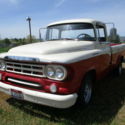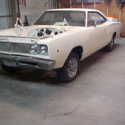Rebuilt engine, starter/generator, distributor, coil, clutch, ready to tour!
| Make: | Dodge |
| Model: | Touring |
| Type: | Touring |
| Year: | 1923 |
| Mileage: | 54480 |
| VIN: | 878501 |
| Color: | Burgundy |
| Engine: | 212 cubic inch inline-4 |
| Cylinders: | 4 |
| Transmission: | 3-speed manual |
| Interior color: | Black |
| Vehicle Title: | Clean |
| Item location: | Macedonia, Ohio, United States |
1923 Dodge Touring Additional Info:
Interestingly enough, the Dodge Brothers story is as closely entwined with the Ford Motor Company as with Chrysler. The Dodge brothers, Horace and John, owned a vast factory in Hamtramck, Michingan that built most of the components for Henry Ford’s early cars; in return, Henry Ford gave them a 10% stake in his fledgling company. In 1914, the writing was on the wall and the brothers realized Ford would soon be moving all production in-house and they’d be out of a job, so they sold their stock back to Ford for $25 million—enough to seed their start-up car company. Given that they already had a fully functional automobile factory, the first Dodge Brothers automobile hit the streets in November 1914. By 1915, the Dodge Brothers were the #3 automaker in the United States and by 1920, they were building 1000 cars a day using 20,000 employees. Sadly, both Dodge brothers passed away in 1920, leaving the company in the hands of long-time manager Frederick J. Haynes. Haynes ran the company for five years until it was sold to a banking firm for $146 million and then to Walter P. Chrysler three years later.
The Dodge Brothers built their company so rapidly based on the rugged durability of their cars and the reputation they had earned with Ford. And there can be little doubt that this handsome 1923 Dodge Brothers touring represents a great deal of car for the money. It has a handsome if conservative look and seems to project an air of toughness—as if this car is ignoring the passage of time. It was restored rather well perhaps 20 or 25 years ago and is holding up well, particularly the maroon paint which still shines up beautifully. Black fenders are a traditional look and there’s minimal bright trim; the custom of the early ‘20s was to paint things like the radiator shell and windshield stanchions. The bright headlight rings are chrome instead of nickel for easy maintenance and the bumpers have been painted silver so they have a somewhat correct look that could easily be upgraded to the correct nickel if you so desire. Ornate step plates on the running boards make the Dodge look more upscale than its price would suggest and the single rear-mounted spare is also practical—the single taillight is mounted inside the rim.
The black leather interior is in excellent condition, surely restored with the rest of the car. Plain pleated benches are reasonably comfortable for touring and the seating surfaces are durable enough to last for many years. With the big wood-rimmed steering wheel, we find it easier to climb aboard through the passenger’s door, but once you’re in place you’ll find the Dodge has more room than a comparable Ford. The controls are laid out more or less the way most of the cars of the period, including an unconventional shift pattern (such things had not yet been standardized in 1923). Round gauges monitor speed, oil pressure, and an ammeter watches the 12-volt generator (all Dodges used 12-volt electrical systems, which is a great feature today). There’s also a Boyce Moto-Meter out on the radiator. Lights are managed by a big switch on the ignition and throttle and spark are managed by levers on the steering column. Front seat occupants get rubber mats, but in back there are relatively plush carpets plus a footrest, another indicator that the Dodge gives you a lot of car for the money. The folding convertible top was probably installed many years ago and remains in good condition save for a small 3-inch tear on the right rear quarter where it folds. It also includes what is labeled as original side curtains, but it actually appears to be a tonneau cover for the seat area.
The 212 cubic inch inline-4 is one tough little engine that featured state-of-the-art technology for the early 1920s, including the “silent start” starter/generator unit that does indeed whisper the engine to life without much noise at all. The engine has been recently rebuilt, along with the distributor, coil, starter/generator unit, and water pump, and it runs superbly. Set the spark and throttle just right and it fires easily and idles well with a gruff 4-cylinder burble from the tailpipe. Bright green engine enamel looks great under the hood, accented by bright yellow spark plug wires and a nicely finished cast iron exhaust manifold. It runs cool and pulls the lightweight touring around without working very hard, cruising comfortably at about 35-40 MPH. For nickel-era touring, this is a fantastic, reliable choice.
The aforementioned 3-speed manual transmission shifts well once you master the unusual shift pattern, and the engine has enough torque that you can leave it in high gear for all but the slowest traffic. Suspension is common to the period with leaf springs and solid axles, and external contracting brakes on the rear wheels only, so plan your stops accordingly. A new exhaust system gives it just the right sound and it sits on tall wood-spoke wheels with 32x4 Firestone “non-skid” tires that are probably as old as the restoration, so if you plan extensive touring a fresh set of rubber would be a smart investment.
It also includes the original owner’s manual, called the “Book of Information,” which has to be the greatest name for a manual ever.
This Dodge quickly won us over with its reliable mechanicals and ready-to-go attitude. It’s also handsome, practical, and an affordable way to get into a nickel-era car that has a lot of recent and expensive service work. Instead of a garden-variety Ford, perhaps this Dodge would be a better choice.
























